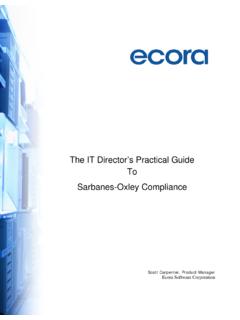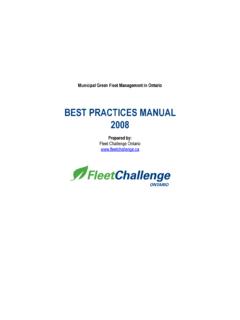Transcription of Patch Management Best Practices - Welcome to Cressida ...
1 1 Patch Management best Practices Whitepaper by: Chris Roberge, MCSE; CCNA Product Manager Cressida Technology Ltd 1 Lammas Gate, 84a Meadrow Godalming, Surrey GU7 3HT, UK Tel: +44 01483 239300 Fax: +44 01483 239383 Email: 2 Table of Contents Executive Summary .. 3 The Problem The Solution The Challenges of Patch Management .. 4 The Solution Patch Management .. 6 Step One Discover .. 8 Step Two Analyze .. 9 Step Three Research and Test .. 10 Step Four Remediate .. 13 Step Five The Safety Net .. 15 Step Six Reporting .. 16 Return to Step One .. 17 Additional considerations .. 17 Conclusion .. 19 Useful Links.
2 20 3 Executive Summary The Problem Speed, accuracy, and security in sending, receiving and storing information have become key to success in business today. When information systems fail, or become compromised due to a security breach, the loss in time, money, and reputation can be disastrous. Despite this simple fact, many organizations today do not have an effective maintenance plan in place to protect the assets they value so dearly: information and the systems that protect it. The Solution The solution to this problem is an effective maintenance plan for your IT infrastructure. That maintenance plan must include an effective Patch Management procedure.
3 This document is intended to help you develop your own Patch Management process by following a series of best Practices developed and proven in the field. While each environment's best Practices will be slightly different, it is still possible to define a general framework around which you can develop your own best Practices . 4 The Challenges of Patch Management In 2001 System Administrators were already increasingly busy with the day-to-day tasks of running a network. The last thing they needed was yet another job to do. Then along came Code Red and and Patch Management became a new server-room buzzword. After Microsoft s sorely needed Trustworthy Computing initiative in the fall of 2001, the Patch flood began, and has since escalated to a torrent of regularly released patches from Redmond.
4 Of course, Microsoft is not the only vendor to require patching. Microsoft has the most widely deployed desktop operating system; however, most enterprises have a multiplatform server environment. The need to apply patches consistently and quickly across UNIX , Linux and other platforms has also become apparent. There is also a growing requirement for Patch Management coverage of database Management systems and applications, as well. Today, patching has become a process that affects all platforms and applications as more and more security vulnerabilities are being discovered and exploited by more and more sophisticated hackers. Figure 1 illustrates the number of vulnerabilities reported by the CIAC (Computer Incident Advisories Capabilities) over the last few years and demonstrates the steady increase in the total number of vulnerabilities exposed annually.
5 (Note Source: CIAC. The CIAC is the division of the US Department of Energy that provides third-party advisories, bulletins and ratings upon discovery of system vulnerabilities. The graph shows the number of Bulletins and Advisories released by the CIAC between 1999 and 2003. Note that the years run from October of the previous year through September of the labeled year.) 1999 2000 2001 2002 2003 The response from the hacking community to the increase in vulnerability identifications has been to step-up their efforts to write code to exploit these vulnerabilities as quickly as possible. In the case of the famous SQL Slammer worm ( ), the 5 internet community had six months between the time when the vulnerability was identified (and a Patch released) and when the worm was actually released.
6 In the case of Nimda, the lead time was nearly a year. More recently, however, the MS Blaster worm ( ) enjoyed only about a month between discovery and exploit. This sense of urgency means patches are often released to fix a problem as quickly as possible. There is often no time for vendors to fully test a Patch for compatibility with all configurations. This introduces an element of risk to the process of Patch deployment. There is no true way to determine the effects of installing a Patch in your environment, short of actually installing the Patch in your environment. One apparent solution to this problem is for IT professionals to constantly monitor vendor s websites looking for the latest security patches, to download them and to apply them to the pertinent machines before vulnerabilities can be exploited.
7 (Most vendors offer notification services which can email users upon release of patches that may pertain to the user s environment.) That still leaves a manual download process, a needed determination as to which machines are affected; testing to verify compatibility, and then a process to install those needed patches onto the appropriate systems. Unfortunately, appropriate machines often number in the thousands. Therefore, a manual patching process is impractical. With so much work involved in Patch Management , some companies accept the risk of not patching their systems and rely instead on strong perimeter security. Of those who do Patch , some Patch only their internet-facing systems, such as websites and email servers.
8 Unfortunately, these solutions do not always help. For one thing, relying solely on perimeter security (firewalls, proxy servers, etc.) assumes your perimeter security is flawless, which is not always the case, and viruses are often written specifically to circumvent perimeter security (or sneak through) as in the case of worms and viruses that are spread as either email attachments or embedded within web pages. 6 The Solution - Patch Management The solution to this growing problem is to develop a series of best Practices . Although the exact procedures followed in each environment will differ slightly, is it possible to define best Practices as a series of guidelines that can be customized to your environment.
9 Once you have decided on your best Practices , automate those Practices through the use of Patch Management software. But first - Executive Buy-in Sometimes the greatest hurdle to overcome is not a technical one. It is crucial, when undertaking any new project, to have the support of senior Management . Making senior managers aware of security risks and the need for patches is important for successfully implementing a Patch Management program and ensuring that appropriate resources are available. Perhaps a quick review of the opening sections of this or any other whitepaper on Patch Management will help convince them that the need is real and based on financial risk.
10 If not, browse or and you can usually find all the alarming statistics you ll need to justify an investment in Patch Management . Patch Management is not an event, it s a process Many companies see Patch Management as something that is event-driven, which is to say, something done in response to an outbreak of some kind. For example, during the SQL Slammer outbreak in early 2003, companies scrambled to install patches across their SQL Server farms. Unfortunately, Slammer took all of nine minutes to spread worldwide. (Not much time to deploy a Patch , let alone research and test one.) This event-based patching philosophy is akin to fixing the barn door after the Trojan horse has come home.









